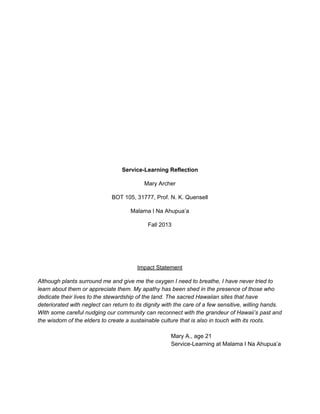More Related Content
More from Mary Archer (6)
Service-LearningReflectionMaryArcher
- 2. Mary Archer 25 Nov. 2013 Ethnobotany 105 MINA SL Reflection
Service Learning Site: Track 1 Mālama I Nā Ahupuaʻa (MINA)
Description: Restoration of ahupua’a, lowland (He’eia Fishpond), midland (Ulupo Lo’i),
upland (Halawa Valley, Ho’oulu ‘Aina).
Role: Student worker. Gardening, cleared streams, used clippers on mangrove.
Hours: 19hr 30min
Additional Hours: ServiceLearning Orientation, 1hr
Service Learning Site: Track 2 Lē'ahi Garden Sensory Stimulus Garden
Description: Upkeep of Leahi Hospital garden. Provide sensory stimulus to
geriatrics.
Leahi Garden, Leahi Hospital, Lions Arboretum
Role: Student worker. Gardening, mulching, work with Leahi Hospital residents.
Hours: 23
Once Hawaiian lands were well cared for. Each ahupua’a had its own ali’i and konohiki,
who oversaw the relationship between the maka’ainana and the land. There were many religious
ceremonies when one took from the land, like when the kahuna lau lapa’au asked permission
from Ku or Hina to take herbs for their male or female patients. However, since the Great
Mahele of 1848 when the majority of the maka’ainana failed to claim private property rights and
were thus disinherited of their land, many important sites, like lo’i, heiaus, and fishponds have
fallen into disrepair. As part of Malama i Na Ahupua’a I have exercised my kuleana to provide
stewardship for the aina. With Le’ahi Garden Sensory Stimulus Garden I have exercised my
kuleana to care for the kupuna.
At He’eia Fishpond I clipped mangrove that leached the nutrients of brackish water
meant for the limu and the fish. I snipped it at the root. Fish and limu are staple foods in the
Hawaiian diet. In days of old fishponds like He’eia’s fed ten thousand strong. With our service
now the herbivorous keiki fish can grow big enough to whet our appetites. From class I learned
the importance of fishponds, and from being at the site I learned the immense scale of a fishpond
- 3. and the sadness that many such fishponds that existed side by side are now non existent, they
have become housing land instead.
At Ulupo Lo’i I tended to wetland kalo. Kalo is a sacred plant, important in Hawaii’s
creation story, where Sky Father Wakea joined his daughter Ho‘ohōkūkalani who gave birth to
Hāloanakalaukapalili, who, born stillborn, was buried and became the first kalo. I cleared tiny
weeds, and grass. I cleared debris from the stream that irrigated the kalo, like leaves, seed pods,
and grass. From class I learned the place kalo has in Hawaii’s culture, and from being at the site I
learned just how depleted the water table is and how that indicates the general erosion of
Hawaii’s ecosystem.
At Halawa Valley I tended to dryland kalo. Again, the bed was overgrown and needed to
be weeded. This time there were weeds with runners that grew laterally three feet long. I cleared
a path of weeds so others could stay clear of keiki kalo, oft stepped on. After an hour of work the
group went on a tour uphill towards the birthing stone. We learned of the courage of the six
aunties who protected Halawa Valley from being bulldozed into an extension of the concrete
plant below. I grew amazed at how the dedication of few, motivated by love of the aina, kept
safe that large valley this many years. From class I learned how the konohiki made sure the
maka’ainana kept the kalo fields in order, and from being at the site I learned what stewardship
looked and felt like.
At Ho’oulu Aina I tended to a Chinese medicine garden. The soil was fertile and full of
insects. There were weeds galore. I was slow and careful in my work, watchful of the actions of
my partner who knew which plants needed to go and which plants needed to be left alone. From
class I learned of the kahuna lau lapa’au’s knowledge of herbs and their medicinal properties and
- 4. how that rivaled Western medicine of the same cultural era, and from being at the site I learned
how fertile Hawaii’s earth is that mugwort grew in abundance.
At Le’ahi Garden I tended to the kupuna, and to the garden meant for the kupuna’s
enjoyment. I rejoined the kupuna with the processes of nature as I presented them with seeds,
soil, and water to plant together. There is something sweet, innocent, and meanttobe seeing
man with nature again. From class I learned that kanaka maoli cared for their kupuna till death,
and from being at the site I learned what care felt like.
When not up in the hospital lanai I was down below, getting my own hands dusty with
red dirt. I worked with indigenous plants like pa’ina’ina, kului, and poha berries, and I worked
with introduced plants like daikon, carrots, and portulaca. As a novice gardener I learned how to
make cuttings, shovel, and water plants. From class I learned about the anatomy of a plant and
the words used to categorize them, like nodes, petiole, pubescent, glabrous, and from being at the
site I exercised that knowledge to take directions, such as when I left at least three nodes for each
oregano cutting.
My experiences with MINA and Le’ahi Garden has changed my view of the community
for the better. I have become aware of what love for the aina and love for the kupuna can feel
like, and how it feels good. I have until now had a mild relationship with my community. I have
never volunteered my hours to its service for this stretch of time.
Protection of the aina is important now, because I believe few can do great things with it.
Through service learning I have achieved my personal goal to understand what a positive
relationship between man and nature felt like. Man appreciates nature and tends to it, and nature
showers its gifts.

